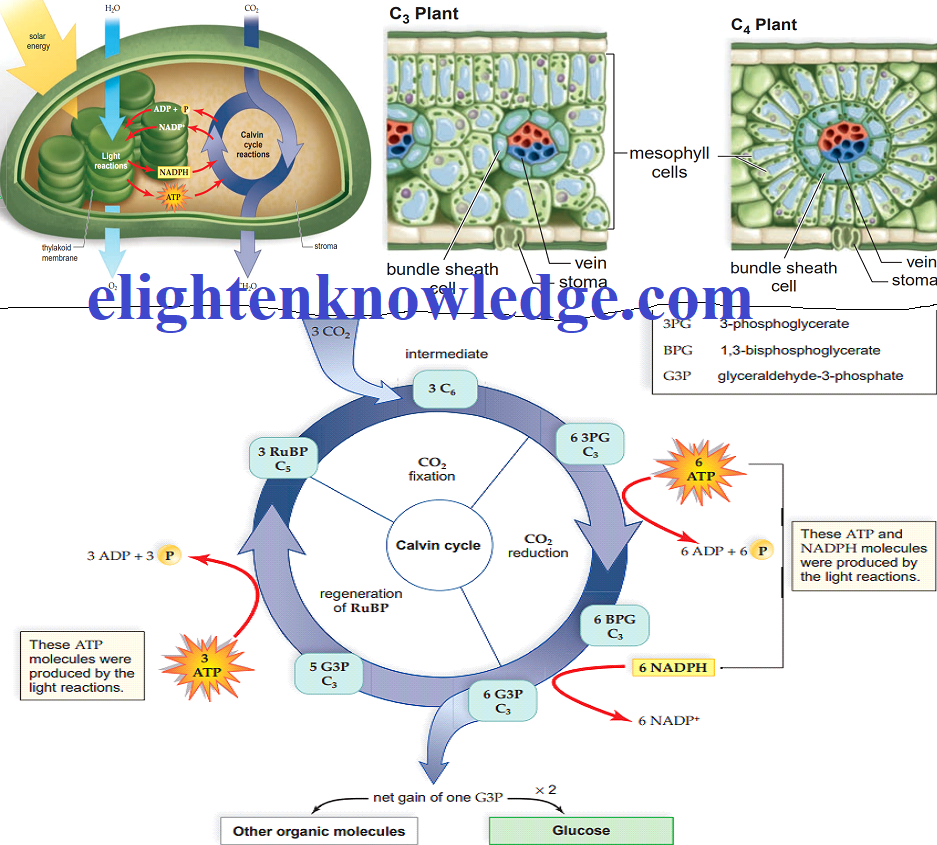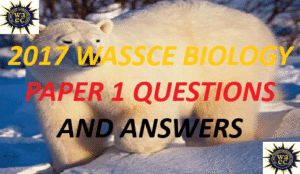Enlighten knowledge exam, sample essay questions on photosynthesis.(P 1).

List three major groups of photosynthetic organisms.
- Plants
- Algae
- Cyanobacteria
Which part of a chloroplast absorbs solar energy, and which part forms a carbohydrate?
- Thylakoid membrane absorbs solar energy
- Carbohydrate is formed in the stroma
Show that the overall equation for photosynthesis is a redox reaction.
- O2 is reduced to CH2O and
- When the oxygen in water gives its H2 (2 H+ + 2 e-), it is oxidized.
In general, terms, describe the light reactions and the Calvin cycle reactions.
- Light reactions use solar energy to split water and produce ATP and NADPH
- Calvin cycle reactions use ATP and NADPH to reduce CO2 to carbohydrates.
What two molecules are produced as a result of the noncyclic electron pathway of the light reactions?
- ATP
- NADPH
What are the three major steps of the Calvin cycle?
- Carbon dioxide fixation,
- Carbon dioxide reduction, and
- Regeneration of RuBP.
List the substances that a plant cell can make from G3P, the product of the Calvin cycle.
- Glucose,
- Sucrose
- Starch
- Cellulose
- Fatty acids
- Glycerol
- Amino
Photosynthesis is the process by which plants, algae, and cyanobacteria capture light energy that is used to synthesize carbohydrates.
During photosynthesis, carbon dioxide, water, and energy are used to make carbohydrates and oxygen.
Heterotrophs must obtain organic molecules in their food, whereas autotrophs make organic molecules from inorganic sources.
Photoautotrophs use the energy from light to make organic molecules.
An energy cycle occurs in the biosphere in which photosynthesis uses light, CO2, and H2O to make organic molecules, and the organic molecules are broken back down to CO2 and H2O through cellular respiration to supply energy in the form of ATP.
In plants and algae, photosynthesis occurs within chloroplasts, organelles with an outer membrane, inner membrane, and thylakoid membrane.
The stroma is the fluid-filled region between the thylakoid membrane and inner membrane. In plants, the leaves are the major site of photosynthesis.
The light reactions of photosynthesis capture light energy to make ATP, NADPH, and O2. These reactions occur at the thylakoid membrane.
Carbohydrate synthesis via the Calvin cycle uses ATP and NADPH from the light reactions and happens in the stroma.
Explain why C4 photosynthesis is advantageous in hot, dry conditions.
- C4 plants prevent oxygen from competing with carbon dioxide for an active site on the enzyme rubisco.
What is the overall outcome of the light reactions in photosynthesis?
- The outcome of light reactions in photosynthesis is the conversion of solar energy into chemical energy that the chloroplasts can use to do work (mostly anabolic production of carbohydrates from carbon dioxide).
Why are carnivores, such as lions, dependent on photosynthesis to survive?
- Because lions eat animals that eat plants.
Why are energy carriers thought of as either “full” or “empty”?
- The energy carriers that move from the light-dependent reaction to the light-independent one are “full” because they bring energy.
- After the energy is released, the “empty” energy carriers return to the light-dependent reaction to obtain more energy.
- There is not much actual movement involved. Both ATP and NADPH are produced in the stroma where they are also used and reconverted into ADP, Pi, and NADP+.
Describe the pathway of electron transfer from photosystem II to photosystem I in light-dependent reactions.
- A photon of light hits an antenna molecule in photosystem II, and the energy released by it travels through other antenna molecules to the reaction center.
- The energy causes an electron to leave a molecule of chlorophyll a to a primary electron acceptor protein.
- The electron travels through the electron transport chain and is accepted by a pigment molecule in photosystem I.
What are the roles of ATP and NADPH in photosynthesis?
- Both of these molecules carry energy.
- In the case of NADPH, it has reducing power that is used to fuel the process of making carbohydrate molecules in light-independent reactions.
Why is the third stage of the Calvin cycle called the regeneration stage?
- Because RuBP, the molecule needed at the start of the cycle, is regenerated from G3P.
Which part of the light-independent reactions would be affected if a cell could not produce the enzyme RuBisCO?
- None of the cycle could take place, because RuBisCO is essential in fixing carbon dioxide.
- Specifically, RuBisCO catalyzes the reaction between carbon dioxide and RuBP at the start of the cycle.
Why does it take three turns of the Calvin cycle to produce G3P, the initial product of photosynthesis?
- Because G3P has three carbon atoms, each turn of the cycle takes in one carbon atom in the form of carbon dioxide.
What are the two stages of photosynthesis?
The two stages of photosynthesis are:
- The light-dependent reactions, in which the energy of sunlight is absorbed and converted into chemical energy in the form of ATP and NADPH;
- The light-independent (dark) reactions, in which electrons carried by NADPH are used as a source of energy to convert carbon dioxide from inorganic to organic form.
In the light-dependent reactions of photosynthesis, light energy is converted to chemical energy when electrons, excited by absorption of light in a pigment molecule, are passed from the pigment to a stable orbital in a primary acceptor molecule.
Chlorophylls are the major photosynthetic pigments in plants, green algae, and cyanobacteria.
Carotenoids are accessory pigments that absorb light energy at a different wavelength than those absorbed by chlorophylls.
Carotenoids may expand the range of wavelengths used for photosynthesis, but their more important role is in photoprotection.
In organisms that split water as their electron source, the pigments are organized with proteins into two photosystems.
Special subsets of chlorophyll a pass excited electrons to primary acceptor molecules in the photosystems.
Electrons obtained from splitting water are used for the synthesis of NADPH and ATP.
In the linear electron flow pathway, electrons first flow through photosystem II, becoming excited there to a higher energy level, and then pass through an electron transfer system to photosystem I releasing energy that is used to create an H+ gradient across the membrane.
The gradient is used by ATP synthase to drive synthesis of ATP. The net products of the light-dependent reactions are ATP, NADPH, and oxygen.
Electrons can also flow cyclically around photosystem I and the electron transfer system, building the H+ concentration and allowing extra ATP to be produced, but no NADPH.
In which organelle does photosynthesis take place in plants? Where in that organelle are the two stages of photosynthesis carried out?
- In plants, photosynthesis takes place in the chloroplast.
- The light-dependent reactions are carried out on the thylakoid membranes and stromal lamellae.
- The light-independent reactions are carried out in the stroma.
What is the difference in function between the chlorophyll a molecule in the antenna complexes and the chlorophyll a molecule in the reaction centers of the photosystems?
- The chlorophyll a molecules in the antenna complexes are normal molecules of the pigment, consisting of a carbon ring structure with a magnesium atom bound at the center and an attached hydrophobic side chain. This chlorophyll a pigments absorb light.
- The chlorophyll a molecules in the reaction centers have modified light absorption properties that result from interactions with particular proteins of the photosystems.
The two special chlorophyll a molecules of photosystem II are P680; those of photosystem I are P700.
- These pigment molecules capture light energy from the antenna complex pigments in the form of an excited electron that is passed to a primary acceptor molecule.
- That electron is passed to the electron transfer system.
How is NADPH made in the linear electron flow pathway?
- The making of NADPH begins when electrons derived from water splitting are pushed to higher energies by light absorption in photosystem II.
- The high-energy electrons pass to a primary acceptor in photosystem II and then down an electron transfer system to P700 in photosystem I, losing energy along the way.
- Light energy absorbed by photosystem I again excite the electrons, which pass to different electron carriers, ending with ferredoxin.
- The ferredoxin transfers high-energy electrons to NADP+, which is reduced to NADPH by NADP+
What is the difference between the linear electron flow pathway and the cyclic electron flow pathway?
- In the linear electron flow pathway, electrons run through the entire set of photosystems and electron carriers, producing both NADPH and ATP.
- In the cyclic electron flow pathway, electrons flow cyclically around photosystem I; photosystem II is not involved. The cycle of electrons is through the cytochrome complex and plastocyanin to photosystem I, to ferredoxin, but then back to the cytochrome complex rather than on to NADP+. Only ATP is produced by this pathway.
How many molecules of carbon dioxide must enter the Calvin cycle for a plant to produce a sugar-containing 12 carbon atoms?
How many ATP and NADPH molecules would be required to make that molecule?
- For each carbon atom that is released from the Calvin cycle in a carbohydrate molecule, one carbon dioxide molecule must enter the cycle.
- Therefore, to produce a molecule containing 12 carbon atoms, 12 molecules of carbon dioxide must enter the cycle.
When does photorespiration occur? What are the reactions of photorespiration, and what are the energetic consequences of the process?
- Photorespiration uses oxygen and releases CO2.
- It occurs when oxygen concentrations are high relative to CO2
- In that condition, rubisco acts as an oxygenase rather than a carboxylase, catalyzing the combination of RuBP with O2 rather than CO2.
- The toxic products formed by this reaction cannot be used in photosynthesis and are eliminated from the plant as CO2.
- Photorespiration uses energy to salvage the carbons from phosphoglycolate, which significantly reduces the efficiency of energy use in photosynthesis.
What is the C4 pathway, and how does it enable C4 plants to circumvent photorespiration?
- In the C4 pathway, carbon fixation involves the reaction of CO2 with phosphoenolpyruvate (PEP) to produce a four-carbon molecule, oxaloacetate.
- The oxaloacetate is reduced to malate by electrons transferred from NADPH,
- Malate then is oxidized to pyruvate in a reaction releasing CO2, which is used in the rubisco-catalyzed first step of the Calvin cycle.
- In C4 plants, carbon fixation and the Calvin cycle occur in different cell types: carbon fixation in mesophyll cells, and the Calvin cycle in bundle sheath cells.
- This alternative method of carbon fixation minimizes photorespiration
How are carbon fixation and the Calvin cycle different in C4 plants and CAM plants?
- In C4 plants, carbon fixation and the Calvin cycle occur in different cell types, mesophyll cells, and bundle sheath cells, respectively.
- In CAM plants, carbon fixation, and the Calvin cycle occur at different times, at night, and during the day, respectively.
C3 plants incorporate CO2 only into RuBP to make 3PG, a three- carbon molecule.
Photorespiration occurs when the level of O2 is high and CO2 is low, which happens under hot and dry conditions.
During this process, some O2 is used and CO2 is liberated.
Photorespiration is inefficient because it reverses the incorporation of CO2 into an organic molecule.
Some C4 plants avoid photorespiration because the CO2 is first incorporated, via PEP carboxylase, into a four-carbon molecule, which is pumped from mesophyll cells into bundle-sheath cells.
This maintains a high concentration of CO2 in the bundle-sheath cells, where the Calvin cycle occurs. The high CO2 concentration minimizes photorespiration.
CAM plants, a type of C4 plant, prevent photorespiration by fixing CO2 into a four-carbon molecule at night and then running the Calvin cycle during the day with their stomata closed to reduce water loss.
How are the reactants and products of photosynthesis and cellular respiration related?
- The reactions of photosynthesis and cellular respiration are essentially the reverse of one another, with CO2 and H2O being the reactants of photosynthesis and the products of cellular respiration.
- Phosphorylation reactions involving electron transfer systems are part of each process, namely, photophosphorylation in photosynthesis and oxidative phosphorylation in cellular respiration.
- G3P is an intermediate in both pathways: in photosynthesis, it is a product of the Calvin cycle, and in cellular respiration, it is generated in glycolysis in the conversion of glucose to pyruvate.
- In photosynthesis, G3P is used for the synthesis of sugars and other fuel molecules, and in cellular respiration, it is part of the catabolism of sugars to simpler organic molecules.





